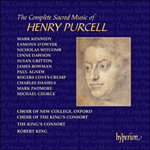This anthem is thought to date from 1688. A comment in the principal source states that the manuscript was ‘copied from a MS in the Revd. Mr Jon. Gostling’s possession & of Mr. Purcell’s handwriting’. The anthem contains splendid writing for the soloist that is especially colourful in its florid Italianate displays.
The stately opening, perfect for Gostling’s remarkable voice, begins with a series of elaborate roulades on ‘glad’ which necessitate a vocal range of over two octaves. ‘Clouds and darkness are round about him’ is set as a triple-metre aria, but dramatic semi-recitative returns at ‘There shall go before him a consuming fire’. Enemies are consumed and lightnings flash, but the most extraordinary writing is reserved for ‘the hills melted like wax’; voice and continuo graphically portray the result of the earth’s submission at the presence of the Lord. The chorus too add their praise of Jehova’s might. Over a running bass line the soloist gives a stately command ‘O, ye that love the Lord, see that ye hate the thing which is evil’, the final word distastefully thrown out at the bottom end of the voice. ‘There is sprung up a light’ returns to a lighter, triple metre, but the florid writing quickly returns with a series of increasingly elaborate displays on ‘joyful’ that are finally taken up by the continuo and then developed in the voice at ‘Rejoice in the Lord’. The choir twice interrupt and finally win the day with a series of Alleluias, but not before Gostling had provided yet another remarkable two-octave demonstration of his astonishing vocal range.
from notes by Robert King ©
The Lord is King, the earth may be glad thereof (
Le Seigneur est Roi, la terre peut s'en réjouir) date probablement de 1688. L'anthem renferme de très beaux passage pour le soliste, qui sont particulièrement colorés dans un style fleuri italianisant. L'ouverture majestueuse, parfaite pour la voix remarquable de Gostling, commence par une série de roulades compliquées sur ‘glad’ (réjouir) exigeant un registre vocal de plus de deux octaves. ‘Clouds and darkness are round about him’ (Nuages et obscurité l'entourent) est présenté dans un air à trois temps, mais un demi-récitatif dramatique revient avec ‘There shall go before him a consuming fire’ (Il sera précédé d'un feu dévorant). Les ennemis sont dévorés par le feu et les éclairs brillent, mais l'écriture la plus extraordinaire est réservée pour ‘the hills melted like wax’ (les collines fondaient comme cire); la voix et la basse continue dépeignent de façon réaliste le résultat de la soumission de la terre devant la présence du Seigneur. Le choeur ajoute aussi ses louanges de la puissance de Jéhovah. Sur une ligne de basse fluide, le soliste donne un ordre solennel: ‘O, ye that love the Lord, see that ye hate the thing which is evil’ (Oh, vous qui aimez le Seigneur, il vous faut haïr ce qui est mal), et le dernier mot est lancé avec dégoût au plus profond du registre vocal. ‘There is sprung a light’ (Une lumière a surgi) reprend un rythme ternaire plus léger, mais le style fleuri revient bientôt avec une série d'ornements de plus en plus compliqués sur ‘joyful’ (joyeux) qui sont enfin repris par la basse continue, puis développés par la voix dans ‘Rejoice in the Lord’ (Réjouissez-vous dans le Seigneur). Le choeur interrompt deux fois et finit par l'emporter avec une série d'Alléluias, mais seulement après une autre démonstration remarquable sur deux octaves par Gostling de son étonnante étendue vocale.
extrait des notes rédigées par Robert King © 1994
Français: Madeleine Jay
The Lord is King, the earth may be glad thereof stammt vermutlich aus dem Jahre 1688. Das Anthem enthält wunderschöne Partien für den Solisten, die in ihrer figurierten, italianisierten Ausstattung besonders farbenfroh sind. Die prächtige Einleitung, wunderbar der außerordentlichen Stimme Gostlings angepaßt, beginnt mit einer Reihe von kunstvollen Läufern bei ‘glad’ [froh], für die ein Stimmumfang von zwei Oktaven erforderlich ist. ‘Clouds and darkness are round about him’ [Wolken und Wetterdunkel um ihn] erscheint als eine Tripeltaktarie, doch bei ‘There shall go before him a consuming fire’ [Feuer brandet um ihn einher] setzt wieder ein dramatisches Halbrezitativ ein. Die Feinde werden von Feuer verzehrt und Blitze erhellen den Erdkreis, aber am auffallendsten ist die Vertonung von ‘the hills melted like wax’ [wie Wachs zerfließen die Berge]: Stimme und Continuo verdeutlichen ausdrucksvoll, wie sich die Erde vor dem Antlitz des Herrn beugt. Auch der Chor stimmt ein im Lob des Herrn. Über der laufenden Baßlinie befiehlt der Solist erhaben ‘O, ye, that love the Lord, see that ye hate the thing which is evil’ [Es liebt der Herr, die hassen das Böse], wobei das letzte Wort mit dem tiefsten Ton der Stimme verächtlich ausgespien wird. ‘There is sprung up a light’ [Licht erstrahlt] ist wieder in einem leichten Tripeltakt geschrieben, aber bei ‘joyful’ [freudig] kehren die Figurationen mit einer Reihe von immer kunstvolleren Verzierungen wieder, werden dann vom Continuo aufgenommen und bei ‘Rejoice in the Lord’ [So freuet euch im Herrn] in der Stimme durchgeführt. Der Chor unterbricht dies zweimal und trägt schließlich mit einer Reihe von Allelujas den Sieg davon, allerdings erst, wenn uns Gostling noch eine prächtige Darstellung seines erstaunlichen Zwei-Oktav-Stimmbereichs vorgeführt hat.
aus dem Begleittext von Robert King © 1994
Deutsch: Meckie Hellary


 Purcell: The Complete Sacred Music
Purcell: The Complete Sacred Music
